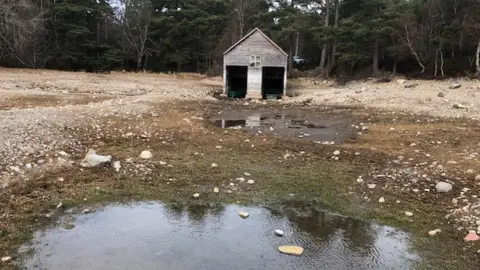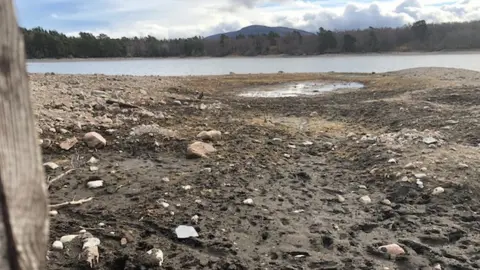Mystery of the disappearing loch in the Cairngorms
A loch in the Highlands has been losing millions of gallons of water since September last year.
Loch Vaa, near Aviemore, is fed by a spring and its usually water-lapped boathouse has been a popular subject for photographers and artists.
But its lease-holders, who offer the loch to the local community and visitors for recreational fishing, say its level has dropped by 1.4m (4.5ft).
Brian O'Donnell said: "It's almost like somebody has pulled the plug."
The Scottish Environment Protection Agency (Sepa) suggested that Loch Vaa had suffered due to a "relatively dry" winter.
 Neil McDade/Spectacular Scotland
Neil McDade/Spectacular ScotlandMr O'Donnell, who helps to run fishing at the loch, said he first noticed the level was dropping after he restocked it with brown and rainbow trout in early September.
He told BBC Scotland: "By mid-September we couldn't get the boats out to fish."
Mr O'Donnell said the Cairngorms loch had lost an estimated 35 million gallons of water so far.
He said: "It is a spring-fed loch, there are no tributaries, so something is happening underground. It's almost like somebody has pulled the plug."
 Brian O'Donnell
Brian O'Donnell Neil McDade/Spectacular Scotland
Neil McDade/Spectacular ScotlandMr O'Donnell said the water loss could pose a risk for wild birds, including grebe, and also the local tourist industry. He said visitors stayed in nearby holiday accommodation while fishing at the loch.
Charlie Whelan, a local angler, expressed sadness at the drying up of the loch.
He said: "Loch Vaa is a unique loch in Scotland because it is gin clear. It is a wonderful fishing loch, especially in evenings."
Mr Whelan blames Scottish Water for affecting the spring.
He said: "It's nothing to do with rainfall. It's completely because Scottish Water, to save money, dug a huge borehole in Aviemore."

But Scottish Water said an underground aquifer and boreholes that supplied water to the Badenoch and Strathspey area were located about three miles (6km) upstream of Loch Vaa, and too far away to affect it.
A spokeswoman said: "Hydrology specialists have advised that given both the geography of the area and the distance between the locations, there is no possibility of a groundwater connection between the boreholes and the water levels in Loch Vaa.
"For water to flow between these sites, a very particular set of geological circumstances would be required and these simply do not exist here."
She added: "The complexity of the glacial geology in the Spey Valley is such that numerous underground barriers to groundwater flow exist between them."
 Brian O'Donnell
Brian O'Donnell Brian O'Donnell
Brian O'DonnellSepa said Loch Vaa was in an area already identified as a potential risk of water scarcity for this year.
A spokesman said: "Although generally considered a wet country, Scotland can be vulnerable to periods of dry weather, which can result in pressure upon the environment and water users in some areas.
"The winter of 2018 -19 has been relatively dry compared to long-term average conditions.
"There has been some rainfall in recent weeks but as Loch Vaa is largely spring fed it will not respond to rainfall in the same way that a river-fed loch would."
